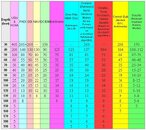luckydiver
Registered
- Messages
- 31
- Reaction score
- 4
I'm looking for firsthand knowledge from folks who have been in this situation and have seen 'standout' good recreational style diving computers at reasonable prices that have not been the most conservative on high frequency diving weeks.
Getting a headache searching and reading the forums to try and piece this info together so looking for a quick to the point answer from someone who's been there, seen it.
I have been looking at computers in the $300 or less price range just to do multi-day nitrox diving and I don't want to be the dive buddy whose computer is the most conservative in this type of profile. A multi selectable algorithm computer seems to be out of this price range from what I've seen.
Hey, is there a Black Friday deal somewhere that brings $600 computer down into the $300 to $400 range?
I have been looking at the Hollis DGO3, Dive Rite NiTek DUO, and similar computers and while I've found a lot of general info, nothing that specifically speaks to how they'd do when diving over 20 dives in a week. I've read people refer to the fact that while on the first dive a particular computer may be 'liberal' or 'average' compared to competitors but that on multi-dive days it becomes too conservative without specifics to help in making a decision.
Getting a headache searching and reading the forums to try and piece this info together so looking for a quick to the point answer from someone who's been there, seen it.
I have been looking at computers in the $300 or less price range just to do multi-day nitrox diving and I don't want to be the dive buddy whose computer is the most conservative in this type of profile. A multi selectable algorithm computer seems to be out of this price range from what I've seen.
Hey, is there a Black Friday deal somewhere that brings $600 computer down into the $300 to $400 range?
I have been looking at the Hollis DGO3, Dive Rite NiTek DUO, and similar computers and while I've found a lot of general info, nothing that specifically speaks to how they'd do when diving over 20 dives in a week. I've read people refer to the fact that while on the first dive a particular computer may be 'liberal' or 'average' compared to competitors but that on multi-dive days it becomes too conservative without specifics to help in making a decision.




